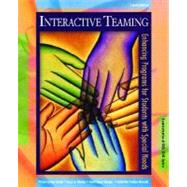Interactive Teaming Enhancing Programs for Students with Special Needs

Interactive Teaming Enhancing Programs for Students with Special Needs
- ISBN 13:
9780131125926
- ISBN 10:
0131125923
- Edition: 4th
- Format: Paperback
- Copyright: 11/01/2004
- Publisher: Pearson
Note: Supplemental materials are not guaranteed with Rental or Used book purchases.
Extend or Purchase Your Rental at Any Time
Need to keep your rental past your due date? At any time before your due date you can extend or purchase your rental through your account.
Summary
Interactive teaming in special programs is a concept of service delivery for schoolage students NN are currently placed in special education programs or are at risk for referral to such programs. The model proposed in this book is based on several assumptions:
- An increasing number of students are failing in the traditional public school program, in both general and special education.
- The needs of individual students are too complex to be handled by a single professional working in isolation, and the needs of all groups of students are too diverse to be addressed by the knowledge base of a single profession.
- Increased diversity in cultural differences, both between professionals and families and among professionals from different cultures, further exacerbates the difficulty both have in providing effective instructional programs and of developing effective communication systems.
- The time of trained professionals and the scarce resources of public education systems are too valuable to be wasted on uncoordinated or duplicated efforts that produce marginal results for students with special needs.
The opening paragraph and previously listed items were the beginning ideas featured in the preface to the first edition of Interactive Teaming, published in 1991. As the fourth edition goes to press 14 years later, the same assumptions are still present and the need for effective teaming models is even greater. The number of students served in special education programs continues to grow, and the cultural diversity of the population continues to increase. Yet, the time professionals have for collaboration and the resources of school systems seem to diminish instead of increase.
During this same time span, much attention has been given to organizational models or school restructuring/ reform efforts that call for skills in collaboration and teaming. Transformational leadership, school-based and site-based management, macro-system reform efforts, inclusion and transition models, and early childhood intervention programs all require collaboration and team decision making to be successful.
The interactive teaming model described in this text is based on transdisciplinary teaming and collaborative consultation models. The model focuses on two concepts:
- Consultation. The sharing of knowledge by one professional with another.
- Collaboration. Mutual efforts between professionals and parents to meet the special needs of children and young people.
The model includes key elements of school leadership efforts, adult learning theories, and recognition of the importance of sensitivity to cultural differences.
This text is divided into three parts, each with several supporting chapters. Part I provides a foundation and overview of the contextual framework within which current and future programs for serving students who have special needs and are at risk will need to be provided. The emergence of a new population of school-age students and the need for a new, coordinated model of implementing special services are highlighted. Part I provides an outline of this model along with comparisons with existing models. The historical development of the new model includes a brief discussion of the models that preceded it: the medical model, the triadic model of consultation, the refinement of the triadic model to collaborative consultation, and the further extension to variations of the school-based and teacher assistance teams. Each represents a step closer to the interactive teaming model proposed in this text; the strengths and documented factors in the effectiveness of previous models have been incorporated into the new proposal.
Part II outlines the facilitating factors that make the teaming model work and addresses the barriers to effective team functioning. The facilitating factors include understanding the roles and perspectives of team members, enhancing communication skills, developing leadership and service coordination skills, empowering team members through professional development, and supporting family involvement. Each factor is presented through a review of the relevant literature with descriptions and examples of applications.
Part III features implementation of interactive teaming in four contexts: programs for (1) students from culturally and linguistically diverse backgrounds, (2) infants and preschoolers with special needs, (3) students with mild disabilities, and (4) students with severe disabilities. The necessary knowledge and skills of team members are described in their roles as direct service providers and as consultants/ collaborators who provide indirect services.
Although the intervention strategies, team members, and their specific interactive processes differ by settings, all teams operate within the framework of problem identification, intervention, and evaluation of effectiveness. The concluding chapter features an extended case study showing how the model is applied, and provides guidelines for implications of interactive teaming for the future.
The guidelines by which the interactive team operates are modifications of those used in school-based management teams. The culture of the school—its values and rules—provides the contextual framework for establishing its goals. Teachers, parents, and other team members-rather than administrators and specialists-are empowered to analyze problems, make decisions, and evaluate programs designed to attain common goals. These goals are related to the provision of effective educational service programs for the students on whom the team focuses its efforts.
This book was developed by an interactive team, with each member serving as consultant and collaborator to the three other members. Although Carol Chase Thomas and Catherine Morsink did not participate in this edition, their contributions continued the spirit of each chanter.






